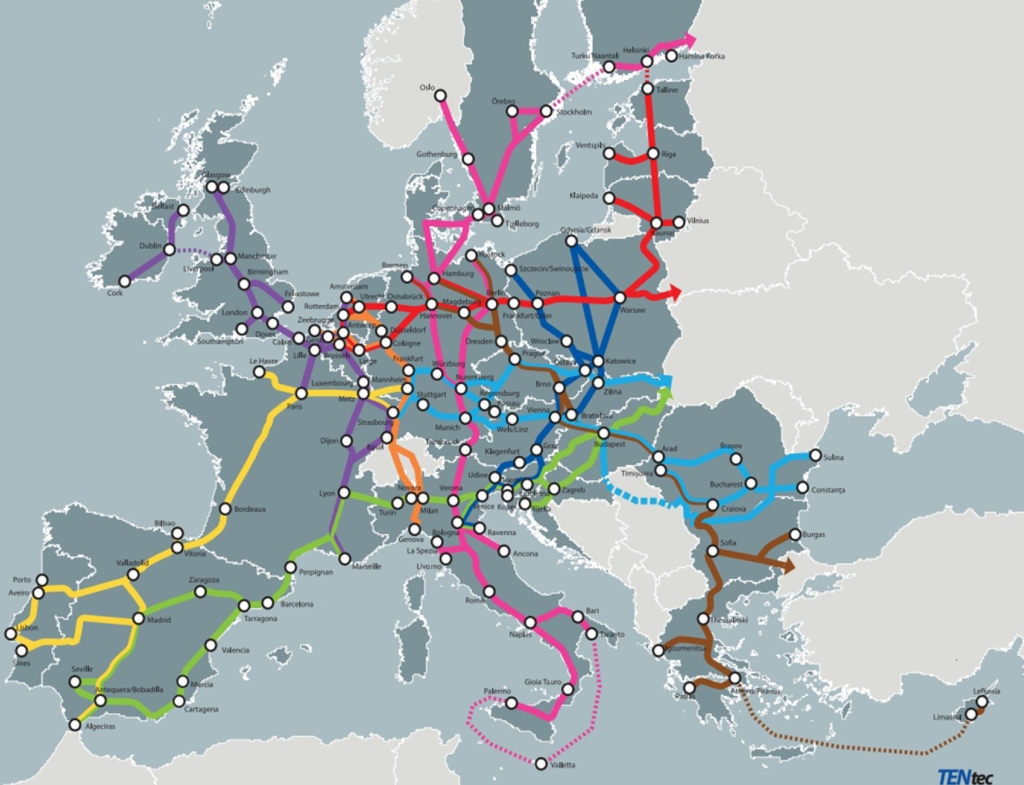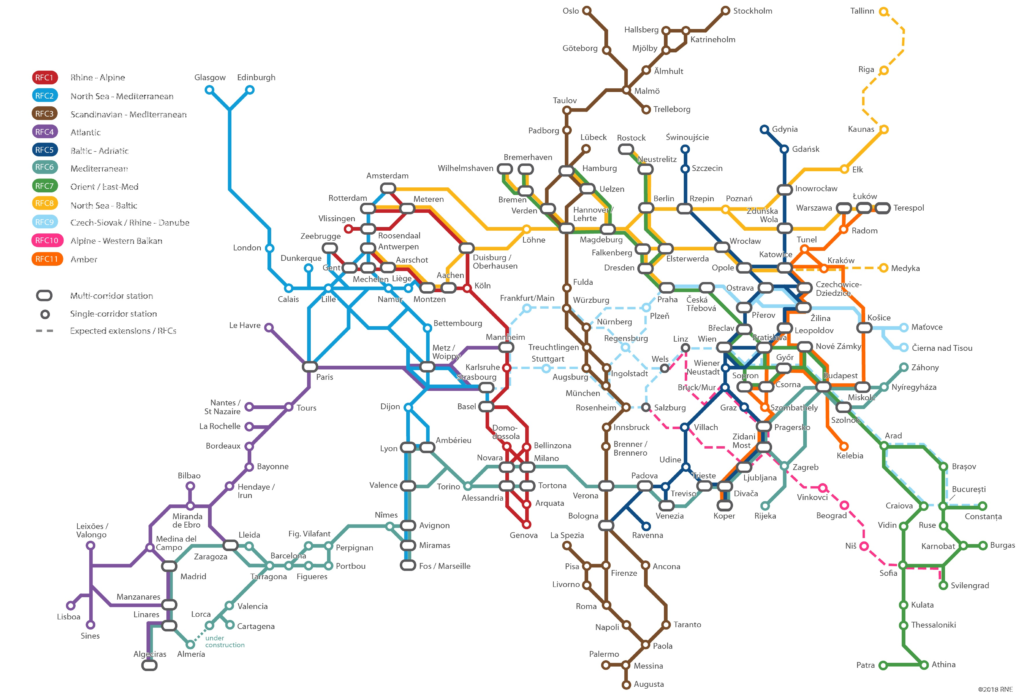Networks
Trans-European Transport Network (TEN-T) Rail Freight Corridors (RFC’s) Cross border – Contingency Management Cross Border – Issues LogbookTrans-European Transport Network (TEN-T)

Objective
The Trans-European Transport Network (TEN-T) is a set of rail, road, air and water transport networks in the European Union. They provide integrated and intermodal long-distance high-speed routes across the continent by taking away border obstacles and removing gaps in the network. This ‘flagship’ project of the EU Transport Policy aims at developing a true European approach to the creation of new transport infrastructure in order to build a real Single European Transport Area.
The TEN-T network for rail (amongst other modes) is regulated by Regulation (EU) No 1315/2013 on Union guidelines for the development of the trans-European transport network. TEN-T is divided into two layers,
- a core-network of routes which should be finished by 2030, and
- a comprehensive network which should be implemented by 2050.
EIM in action
- EIM supports the transport policies implementing the TEN-T legislation (including the ‘Smart TEN-T’ proposal), and advocates sufficient funding and support on European and national level to achieve the TEN-T goals.
2019
- EIM supported the campaign and petition ‘MoreEUbudget4transport’ in order to secure sufficient funding for the completion of the TEN-T network;
- EIM replied to the European Commission evaluation for a potential revision of the TEN-T Guidelines.
Outlook 2020
- EIM will publish a joint position paper together with CER outlining its position regarding the revision of the TEN-T Regulation;
- In 2020, the European Commission will adopt a legislative proposal to streamline the permit-granting procedures for the development of infrastructure that is part of a TEN-T line, the so-called ‘Smart TEN-T proposal’. EIM has provided input throughout the entire legislative process.
Rail Freight Corridors (RFC’s)

Facts & context
The Rail Freight Corridors (RFCs) have been designed to promote the transport on rail. Regulation 913/2010 on the establishment of a European rail network for competitive freight fosters i) the cooperation between the different stakeholders, including Member States and Infrastructure Managers (IMs); ii) the coordination in terms of capacity offers; iii) traffic management; iv) infrastructure works and conditions of use of the infrastructure; v) the harmonisation of processes and rules; vi) the development of the infrastructure and the related coordination in terms of investments. The development of each RFC is monitored through an annual performance report and an annual customer satisfaction survey.
EIM in action
- EIM actively participates in the various platforms promoting and improving the RFCs;
- EIM supports the principle that RFCs contribute to the decarbonisation of transport by facilitating a modal shift for freight from road to rail.
2019
- EIM closely followed all initiatives of the rail sector to promote RFCs;
- DG MOVE launched an evaluation of the current RFC Regulation in 2019;
- EIM participated in all public consultations dealing with RFCs and the revision of the Regulation.
Outlook 2020
- EIM will publish a position paper together with other rail actors concerning the revision of the RFCs;
- EIM will communicate its position through bilateral contacts with DG MOVE and later on during the legislative process with other relevant stakeholders.
Cross border – Contingency Management
Facts & context
On 16th May 2018, RailNetEurope (RNE) and the Platform of Rail Infrastructure Managers in Europe (PRIME) approved the ‘International Contingency Management Handbook’. It describes rules and procedures in the case of disruptions on a rail network which impacts cross-border traffic on a Rail Freight Corridor (RFC). The Handbook is a guideline with standardised procedures. It also clarifies the division and distribution of responsibilities in the case of a contingency management.
EIM in action
- EIM has been closely involved in the preparation of this document;
- EIM and its members understand the importance of a harmonised contingency management to support seamless cross-border rail operations.
2019
- EIM and its members continue to contribute to the handbook through the PRIME platform. The Handbook was first published in March 2018.
Outlook 2020
- EIM and its members continue to attend the International Contingency Management Plenary sessions organised by the European Commission to provide feedback on the Handbook.
Handbook for International Contingency Management
Cross Border – Issues Logbook
Facts & context
In March 2017, DG MOVE launched a “Rail Technical Operational Issues Logbook”. Its main aim is to identify barriers to interoperability hampering international rail freight traffic, especially on Rail Freight Corridors (RFCs). It shall allow all stakeholders to identify issues and potential solutions. The Infrastructure Managers (IMs) will be requested to report about various operational issues, such as braking safety, train composition, border checks, etc.
EIM in action
- EIM contributes to the Joint PRIME/RU Dialogue meetings dealing with the Issues Logbook;
- EIM and its members contribute to the yearly ‘Issues Logbook Plenary Meeting’ organised by DG MOVE.
2019
- EIM closely followed the Issues Logbook initiatives as IMs are strongly involved in the project;
- The Issues Logbook is a living document. In 2019, it focused on three topics:
- Braking
- Train Composition and Border Checks
- Real time communication about train composition
Outlook 2020
- Solutions to the issues identified in the Issues Logbook will be further developed in 2020. To reach this purpose, DG MOVE has contracted with a consortium of consultancies via public tender at the end of 2019.
